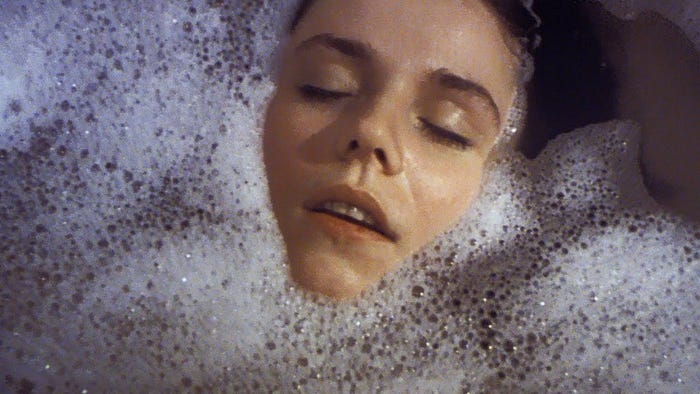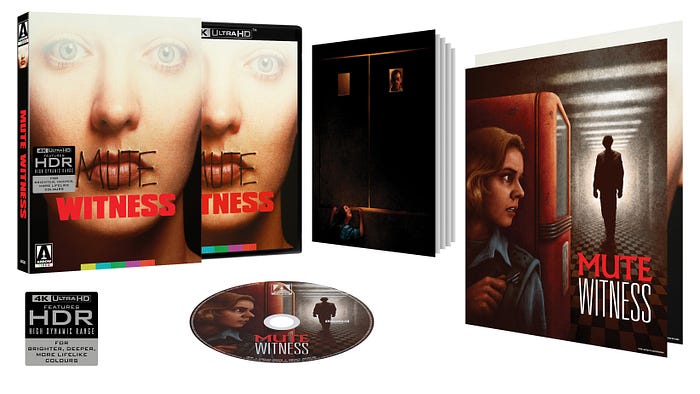Blu-Ray Spotlight: Mute Witness 4K Limited Edition
Anthony Waller’s 1995 thriller is no longer hard to find thanks to Arrow’s excellent release.

The 1990s were a freewheeling time for murder mystery suspense thrillers (including the interchangeability of this particular four-word genre label). Many films during this time aimed to either weaponize overt sexuality, imitate as closely as possible the kernels of ideas and aesthetics of DePalma and/or Hitchcock, or try the same with the Verhoeven model (see: Basic Instinct) and try for as over-the-top as possible.
This brought extremely mixed results of course, as there are reasons why there are exactly one Verhoeven, one DePalma, and one Hitchcock. So many of these similarly-minded films wanted to be the above so bad that they lost valuable personality in the pursuit, or took on other qualities entirely that weren’t necessarily in its original intent. But Mute Witness doesn’t feel like one of those films, despite how loud the Hitchcock bell rings throughout its tense runtime.
It legitimately feels like a film made because the core idea was so intriguing it had to be made. To prove how much it deserved to be on the screen in the journey its creation was so difficult that major components were changed to serve the production both in front of and behind the camera. That doesn’t happen a whole lot. Mute Witness has had a long decrepit life on an old DVD release from 2003 which Sony seemed to have purposefully forgotten about, and Arrow Video’s revitalizing restoration finally brings this bright spot of the ’90s murder-mystery-suspense-horror-thriller (however many genre tags you want to put on them work, mostly) craze to the forefront almost 10 years after its release.
Video

Mute Witness boasts a brand-new 4K restoration from the original camera negative approved by writer/director Anthony Waller, in its original 2:35.1 aspect ratio. While Mute Witness looks dramatically better than its 21-year-old DVD the visual quality tends to differ across the experience with color temperature changes, grain levels, and general quality contrasts that point more to the condition of the negative itself.
Given that this film has had a troubled production history it wouldn’t be altogether surprising that the development process and post-production faced related issues. For instance, the footage of Alec Guinness’s small scene shot in Hamburg look nearly immaculate (likely due to the fact that it was shot almost 10 years before the rest of the film was shot — more on that below) while most of the Russia-shot exteriors and interior studio sequences have a much grainier and gritty look to them.
There is still a decisive usage of color that remains consistent for bluer exterior night shots and typically warmer orangey-reds for comfortable interiors (the former serving more sinister and relatively barren indoor spaces of the liminal variety). But in focusing on ancillary character scenes there is much more of a flat monochromatic quality to them, visually and textually.
I’m unsure where the negative development occurred but given that the production had to dig deeper to pay for twice their projected budget, some development could have taken place in Russia or the US which would explain its varied states of quality. But make no mistake, this points more to the merits of the film’s look and well-captured details that remain quite crisp that feed into the suspense and horror of the narrative it needs to immerse us within.
When we have to be convinced that a fictional film we’re watching covers a special effects makeup artist being so sure she has seen a real killing within the knowledge that we ourselves are watching a fictional depiction of both simulated and actual murder and it works, the quality of the visual medium goes a long way to sell that idea. In a way the heavier natural grain levels and differing color timings sell that first and foremost before the performances (which are genuinely wonderful and superb in the case of Zudina’s titular mute witness Billy Hughes).
Audio

Mute Witness features a singular stereo LPCM track in the original English and Russian dialogues. According to a comparison with the previous Sony DVD (that is now of legal drinking age), this stereo track seems to have a wider sound to compensate for some home theater or soundbar-level setups for immersive purposes.
This makes certain sequences hit harder than before but also emphasizes the usage of ADR/post loops that can have repercussions on the immersive factor. Thankfully not a whole lot was used and it’s consistently only visually noticeable rather than aurally incongruent as tends to be the case with most productions that utilize the technique.
The balance between dialogue, score, and Foley effects is optimal rendering everything on a clean consistent level without the need for volume surfing. The disc also offers optional English subtitles for the deaf and hard of hearing.
Special Features

The special features for Mute Witness are arrayed impressively on this single-disc release, notably with 2 brand new commentary tracks and a handful of interviews, as well as the entire set of raw footage shot in Hamburg with Sir Alec Guinness.
The full list of extras is as follows:
- Brand new audio commentary by writer/director Anthony Waller: Waller talks through the process of the making of the film, recounting stories prevalent across the interviews on the disc but much more detailed in the difficulties he and his crew ran into both on and off the set.
- Brand new audio commentary with production designer Matthias Kammermeier and composer Wilbert Hirsch, moderated by critic Lee Gambin
- The Silent Death, brand new visual essay by author and critic Alexandra Heller-Nicholas, examining Mute Witness and its relationship with snuff films
- The Wizard Behind the Curtain, brand new visual essay by author and critic Chris Alexander, exploring the phenomenon of the film-within-a-film
- Original “Snuff Movie” presentation, produced to generate interest from investors and distributors, featuring interviews with Anthony Waller and members of the creative team
- Original location scouting footage: Prior to the film’s production moving to Moscow, this footage is of either one or multiple brick warehouse exteriors and interiors in Boston, with occasional driving footage
- Original footage with Alec Guinness: filmed approximately 8 years prior to the rest of Mute Witness, this was the very first footage ever shot for the film in a private garage in Hamburg, Germany. Waller’s commentary sheds light on how this footage came to be, as well as the above featurette Original “Snuff Movie” presentation
- Teaser trailer
- Trailer
- Image gallery
- Reversible sleeve featuring original and newly commissioned artwork by Adam Rabalais
- Double-sided foldout poster featuring original and newly commissioned artwork by Adam Rabalais
- Illustrated collector’s booklet featuring new writing on the film by Michelle Kisner
Note: all special features share the same disc with the film in this single-disc release.

Final Thoughts

Mute Witness probably isn’t going to knock anyone’s socks off at this point, but the course of the film’s journey does provide some fairly well-crafted moments of tension. The real issue may just be in the release of its tightly wound nature, where Billy’s run-and-hide sequence is excellent as we watch but devolves in a frankly misogynist presentation of “hyperactive female imagination” even in the face of her professional conviction that she did indeed witness a murder being filmed. This continues in the treatment of her by in-film director Andy Clark (Evan Richards, Society, Altered States) yet remains unchallenged by Billie’s sister Karen (Fay Ripley, Fungus the Bogeyman, Rosanna’s Grave).
And this could very well be an intended position for the film to put us in, however it doesn’t lead the film’s gender politics anywhere substantial or conclusive. It becomes more preoccupied with the cat and mouse-like chase of the killers and Billy’s protective circle struggling to keep out of the authorities’ way while trying to stay alive. This is by no means an exception to the rule of a ’90s thriller having some truly uninspired moments, but its central idea and examination of real versus simulated peril keeps it going. Maybe a Hitchcock comparison as a whole is going too far but there are occasional flashes of brilliance that the British-American filmmaker would have stolen for his own purposes had this film been written and passed around Hollywood during his heyday.
You’d certainly not see something like Mute Witness before but its influence on referential filmmaking is something to be considered and certainly not ignored. Nevertheless Mute Witness is a thriller that rises above a fair amount of the rest of its ’90s counterparts, and due to its relative unavailability and fascinating rocky production history (as evidenced in the commentary tracks and featurettes above), this release from Arrow comes recommended.
